How to diagnose and bypass a defective detonation sensor in a 90+ Nissan 300 ZX Twin turbo.
My Z is a 1992, "Continental European" Nissan 300 ZX Twin Turbo, 2+2 (!!) (left hand drive). All the tests have been done on this car. Hopefully, this applies to all the Z32 all over the world.
Special thanks to the "Jim Wolf Technology" Team, as Jim and Clark helped me understand a few technical points about this problem.
You probably have a failing detonation sensor if...
If you don't know how to put your ECU in test mode, go there..... Twin Turbo Zs of Dallas (excellent site, with a lot of accurate technical info)
Tools required :
First of all, locate the detonation sensor connector.
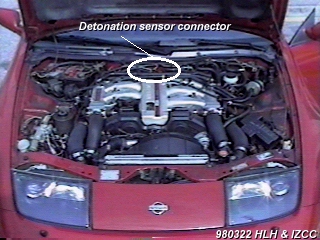
Let's get closer.
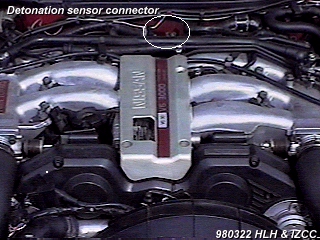
And even closer.
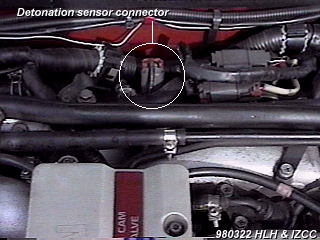
Now, unplug the connector.
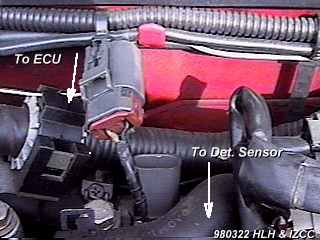
The part that is "free to move", is going towards the ECU.
The part of the connector that stays on the engine block is going to the detonation sensor.
During all the following part, it's assumed that your car is a STOCK one, and that there are no special surgery done with the ECU.
If you ever tried to fix the problem yourself, cutting ECU wires, splicing connections, or whatever, REVERT everything back to the stock configuration before proceeding.
Do the following tests :
Using the multitester as an ohm-meter, test the connections going to the ECU.
If you have a problem with one of the wires going to the ECU
If you have a problem with one of the wires going to the detonation sensor
If you still have a problem with one of the wires ...You have the following options..
If Nissan's engineers decided to intall a detonation sensor on the VG30DETT engine, it's because they have a whole bunch of good reasons to do it. If you decide to follow the "bypass the detonation sensor" instructions, your ECU won't be able to "listen" to detonation anymore, and that could cause the destruction of your engine....you've been warned.
First of all, an additional test to be sure.
Required material :
Actions :
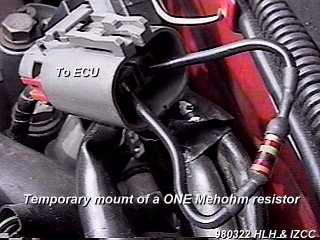
If you still have a code 34, then the problem is NOT your detonation sensor. Either the wires going to the ECU are defect, or the resistor you've been using is NOT one megohm.
At this point, you will have to decide if you'll have your engine repaired (IMHO, the right thing to do), or fix it.
Bypassing the detonation sensor
Ok, you're still with me, so you take full responsabilities about the possible consequences of the installation.
Required material :
Actions :

Note : The way the resistor is installed, if the detonation sensor suddenly re-starts working (due to an intermittent problem), the car will immdiately go back in "fail safe mode", and it's exactly what I want. If you don't want this, then you can either leave the connector unplugged, or cut the wire(s) going to the detonation sensor.
It's now time to test-drive your Z. As an insufficient engine temperature can trigger a fail safe mode as well, you need to have the engine warm, and then go for it. At that point, you should get your full boost back.
If you still don't have full boost, check your ECU again.
If you have a code 55 (all's OK), then it means that your Safe Boost Solenoid Valves might be defective.
They could be defective because "someone" cut a wire at the ECU not fully understanding all the relevant issues, or that the ECU is defect, or that the Valves themselves are out.
But there are as well other possible causes of a "fail safe mode"
Anyway, at that point, you should read the "how to install an electronic boost controller in a 90+ Z" (), and probably buy an EVC as well.
Zee you
Written by H. Le Hir / 980325@00:51 email 100031.1520@compuserve.com